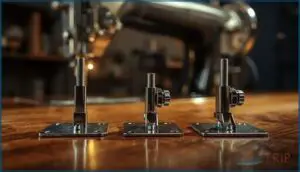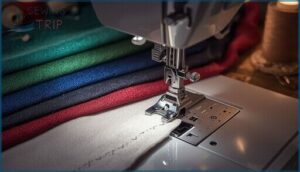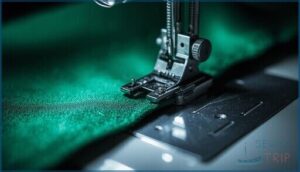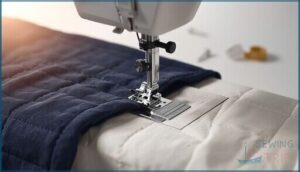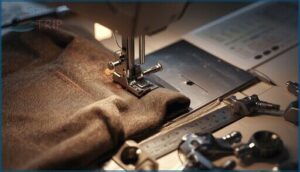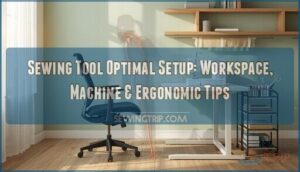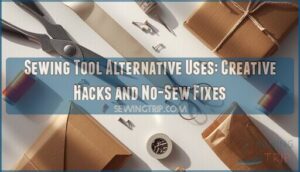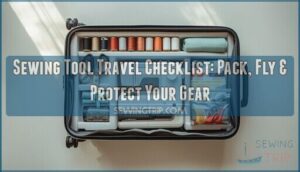This site is supported by our readers. We may earn a commission, at no cost to you, if you purchase through links.
You’ve just scored a gorgeous walking foot on sale, but when you get home, it won’t attach to your machine—the shank doesn’t fit. This frustrating scenario plays out in sewing rooms everywhere because sewing machine feet aren’t universal.
Your machine’s shank type, whether low, high, or slant, determines which presser feet will work, and using the wrong one can damage your equipment or produce terrible stitches. Most sewers assume feet are interchangeable across brands, but compatibility depends on several technical factors beyond just the manufacturer’s name.
Understanding your machine’s specifications and knowing how to identify compatible attachments transforms you from guessing in the accessory aisle to confidently building a collection that expands your sewing capabilities.
Table Of Contents
- Key Takeaways
- Are Sewing Machine Feet Universal?
- Factors Affecting Presser Foot Compatibility
- Types of Sewing Machine Feet Explained
- How to Identify Compatible Sewing Machine Feet
- Universal Presser Feet and Adapter Options
- Common Compatibility Issues and Solutions
- Tips for Choosing The Right Sewing Machine Feet
- Frequently Asked Questions (FAQs)
- Conclusion
Key Takeaways
- Sewing machine feet aren’t universal across all machines—compatibility depends on your shank type (low, high, or slant), with roughly 90% of home machines using low shank systems that allow snap-on foot swapping between brands like Brother, Janome, and Singer.
- You can’t assume feet from one brand work on another without checking shank height, attachment method, and brand-specific requirements, since European manufacturers like Bernina use proprietary systems while Japanese brands often share compatibility.
- Using incompatible presser feet risks serious damage including needle breakage, machine motor strain, fabric tearing, and stitch quality problems—always measure your shank height and verify specifications before purchasing new feet.
- Building a versatile presser foot collection starts with 6-11 essential pieces matched to your fabrics and techniques, then expands based on your projects, with adapters bridging gaps between different shank systems when needed.
Are Sewing Machine Feet Universal?
Are most presser feet truly interchangeable across machines? The answer isn’t as simple as yes or no. While universal sewing machine feet exist, they’re not compatible with every machine on the market. About 90% of home sewing machines use low shank systems, which means you can swap snap-on presser feet between many brands like Brother, Janome, and Singer. However, the term “universal” specifically refers to compatibility within the same shank category, not across all brands and models.
Universal sewing machine feet aren’t truly universal—they only work within the same shank category, not across all brands and models
High-shank machines, industrial models, and specialized equipment like vintage Singer slant shank or Bernina machines require their own specific feet. Understanding sewing machine feet compatibility and shank systems is vital before you invest in new presser feet. Adapter options can expand your choices, but you’ll need to verify foot compatibility with your specific machine first.
To master every foot, it’s important to learn about presser foot maintenance.
Factors Affecting Presser Foot Compatibility
Before you buy a new presser foot, you need to know what makes one foot work with your machine while another won’t fit at all. The answer isn’t as simple as “one size fits all,” because several mechanical factors determine whether a foot will attach properly and function correctly.
Let’s break down the three main compatibility factors that control which feet you can actually use on your sewing machine.
Shank Types (Low, High, Slant)
Understanding shank type is your first step toward mastering sewing machine feet compatibility. Low shank machines, measuring roughly ¾ inch from screw to footplate, dominate the market and work with universal sewing machine feet. High shank systems sit at 1¼ inches, while slant shank designs angle uniquely at 1⅛ inches.
Incorrect shank measurement leads to compatibility issues, sewing errors, and potential machine damage, making foot adaptation critical for success. To confirm proper compatibility, it’s vital to grasp the different shank types available when selecting sewing machine feet.
Machine Brand and Model Differences
Beyond shank heights, machine brand and model specifics dramatically reshape compatibility. Japanese brands like Brother, Janome, and Singer often share snap-on universal sewing machine feet, while European manufacturers like Bernina demand proprietary systems.
High-end models within brands may reject lower-tier feet, creating compatibility issues even among the same manufacturer. Generic foot adapters bridge some gaps, but brand variations mean you can’t assume interchangeability without verification.
Needle Systems and Foot Attachment Methods
Needle alignment directly affects presser foot mechanics. Most domestic machines use the 130/705H needle system, which influences shank designs and attachment types essential for sewing precision.
Industrial models employ different systems, creating distinct sewing machine compatibility challenges. Your machine’s needle positioning determines which sewing machine feet will function properly.
Snap-on versus screw-on attachment types, combined with shank type variations, mean universal sewing machine feet aren’t truly universal across all platforms.
Types of Sewing Machine Feet Explained
Now that you understand what affects compatibility, let’s get practical and look at the actual feet you’ll encounter in your sewing room. Each foot is built for a specific job, and knowing what they do helps you pick the right tool for your fabric and technique.
Here’s a breakdown of the most common presser feet and what makes each one essential for different projects.
Universal/Zigzag Foot
You’ll find the zigzag foot, sometimes called the universal presser foot, included with most sewing machines for good reason—it’s built for stitch versatility.
This foot’s wide opening and solid construction let you handle straight stitches, decorative patterns, and zigzag work across different fabrics.
Its machine adaptability makes it your go-to choice for around 80% of standard projects, delivering consistent sewing efficiency without constant foot changes.
Zipper Foot
Your zipper foot transforms zipper installation from frustrating to precise with its narrow design that places stitching right against zipper teeth. This presser foot gives you foot adjustment flexibility—shift it left or right of the needle for lapped or centered applications.
Whether you’re tackling invisible zippers on silk or heavy-duty versions on canvas, matching zipper types to fabric compatibility ensures sewing precision every time.
Walking Foot
Your walking foot elevates fabric feeding and stitch quality by engaging both top and bottom layers simultaneously, which prevents shifting during quilting techniques. While universal sewing machine feet exist for basic tasks, no truly universal walking foot spans all brands—compatibility depends on your machine’s shank type and model specifications.
Key walking foot considerations:
- Low shank machines accommodate most walking feet, while high shank and slant shank require specific versions or adapters
- Brand-specific designs like Bernina’s interchangeable soles or Janome’s built-in dual feed systems demand precise presser foot matching
- Triple compound feed machines handle heavier materials better than standard top-and-bottom feed systems
- Regular foot maintenance according to manufacturer instructions maximizes sewing efficiency and performance
Verify your model number before purchasing to confirm proper sewing machine compatibility and maintenance.
Buttonhole Foot
Your buttonhole foot transforms intricate closures into efficient operations through automatic or manual stitching sequences. Buttonhole types vary markedly—automatic versions with size sensors contrast with sliding four-step models requiring manual control.
While universal sewing machine feet offer basic functionality, presser foot compatibility depends on shank height and brand-specific attachment methods, affecting sewing accuracy and stitch quality.
Verify your machine’s specifications before selecting foot accessories to guarantee proper fabric compatibility and sewing machine compatibility and maintenance.
Quilting and Specialty Feet
Quilting and sewing demand precision beyond standard presser foot capabilities, which is why specialty quilting feet deliver enhanced fabric handling improvements. These attachments enable sophisticated quilting techniques through improved stitch regulation and accommodate diverse quilter preferences:
- Walking feet prevent layer shifting during multi-fabric quilting
- Free motion feet enable unrestricted creative stitch patterns
- Quarter-inch feet maintain consistent seam allowances
- Stitch-in-the-ditch feet create invisible quilting lines
- Roller feet glide smoothly over textured materials
Verify compatibility with your machine’s shank type before purchasing universal sewing machine feet.
How to Identify Compatible Sewing Machine Feet
Before you buy a presser foot, you need to know what you’re looking for. Picking the wrong foot wastes money and can even damage your machine if the attachment doesn’t match your shank type.
Here’s how to identify compatible feet so you get it right the first time.
Checking Shank Height and Type
Getting your shank height measurement right is the foundation of presser foot compatibility. You’ll measure from the center of the presser foot’s screw hole to the needle bed with the foot lowered. Low shank machines usually measure about ⅔ inch, while high shank machines are around 1 ⅔ inch. This simple check prevents costly mistakes and ensures your foot attachment methods work flawlessly.
| Shank Type | Shank Height | Common Machines |
|---|---|---|
| Low Shank | ⅔ inch (2 cm) | Brother, Janome, Singer |
| High Shank | 1 ⅔ inch (3+ cm) | Industrial, long-arm |
| Slant Shank | 1 1/8 inch (angled) | Vintage Singer (50s-60s) |
Measuring and Matching Attachments
Once you’ve confirmed your shank type, measure your foot alignment with a ruler under good light. Check the distance from screw to base plate, then compare attachment methods—snap-on or screw-on—against your machine’s specs. Compatibility checks prevent needle strikes and poor stitching.
When standard sewing machine feet don’t fit, adapter types bridge the gap between presser feet and non-standard shanks, expanding your options without sacrificing precision.
Consulting Manufacturer Specifications
Before buying any presser foot, pull out your machine’s manual or visit the manufacturer’s website for official compatibility charts. These resources break down exactly which feet work with your specific model based on shank type and attachment system. Brother, Janome, Pfaff, and Husqvarna all maintain detailed guides that prevent costly mistakes.
Check for:
- Model-specific accessory lists showing compatible sewing machine feet by shank height
- Adapter recommendations if you’re eyeing universal options for your machine brand
- Stitch width limitations that affect specialty foot performance on newer models
Universal Presser Feet and Adapter Options
Universal presser feet can open up your options, but you’ll need to understand how they attach to your machine. Not all feet work the same way, and some machines require adapters to make them fit properly.
Here’s what you need to know about snap-on versus screw-on systems, adapter solutions, and brand-specific requirements.
Snap-on Versus Screw-on Feet
You’ll encounter two main presser foot attachment systems: snap-on and screw-on designs. Snap-on feet offer ease—just press a lever for quick changes, perfect for modern low-shank and high-shank machines. Screw-on feet provide security through manual fastening, favored for heavy fabrics.
Shank variations affect compatibility, but adapter solutions bridge the gap between systems, enhancing foot durability and versatility across sewing machine feet types.
Adapters for Different Machines
Adapter types enable compatibility across machine brands, letting you convert screw-on to snap-on systems or bridge shank height differences. Low-shank adapters fit machines measuring ¾ inch from screw to footplate, while high-shank versions accommodate 1¼ inch heights.
Consider these adapter solutions:
- Low-shank snap-on adapters for Japanese brands like Brother, Janome, and Singer
- High-shank adapters for Pfaff and Husqvarna Viking machines
- Skinny snap-on adapters for specific Singer models
- 5mm and 7mm shank width adapters for broader brand compatibility
- Zinc alloy and durable plastic constructions for mechanical reliability
Brand-Specific Solutions (e.g., Bernina)
Bernina sewing machines use proprietary systems that require specialized adapters to work with universal presser feet. Older Bernina models feature rounded shanks, while newer versions have squared shanks with notched cutouts supporting wider stitch widths.
You’ll find Bernina adapters designed for both old and new style feet, though using them may disable certain machine-specific sensors. Check your machine’s stitch width capacity before purchasing compatible Bernina sewing machine feet and attachments.
Common Compatibility Issues and Solutions
Even when you’ve done your homework on shank types and adapters, things can still go sideways when you attach the wrong foot to your machine. Incompatible feet don’t just sit there looking awkward—they can cause real problems with stitch quality, fabric feeding, and even damage your equipment.
Let’s walk through the most common issues you’ll face and how to fix them before they cost you time or money.
Misalignment and Poor Stitch Quality
When your presser foot doesn’t sit right, your stitches tell the story. Misalignment causes a cascade of quality problems that can sabotage even your most careful work, turning reliable sewing machines into frustrating puzzle boxes.
- Stitch defects like skipped or wandering stitches appear when needle and presser foot alignment is off
- Fabric puckering results from improper compression, wrecking seam appearance and garment durability
- Thread breakage and needle damage increase as misaligned presser feet force components into contact
- Sewing precision drops dramatically, with mechanical faults accounting for roughly 70% of stitch control issues
Risks of Using Incompatible Feet
Compatibility errors don’t just frustrate you—they threaten your machine and projects. Using incompatible presser feet creates risks spanning machine damage to fabric tears, needle breakage to stitch errors. Understanding these hazards enables you to protect your investment and maintain sewing precision.
Incompatible sewing machine feet force needles into contact with metal edges, causing breakage that damages internal mechanisms. Misaligned presser foot openings restrict stitch width, producing errors you can’t fix through tension adjustments alone. Generic feet with rough undersides snag fabric, while improper pressure distribution creates bunching that ruins seam integrity. Motor strain increases when feet don’t match your sewing machine specifications, accelerating wear on components you can’t easily replace. These compatibility failures transform routine projects into expensive repair scenarios.
| Risk Category | Common Consequences |
|---|---|
| Machine Damage | Needle bar stress, feed dog misalignment, shank wear |
| Fabric Damage | Snagging, puckering, distortion on delicate materials |
| Performance Issues | Skipped stitches, tension problems, uneven feed |
| Safety Hazards | Needle strikes, mechanical interference, warranty voids |
Tips for Safe Foot Attachment
Proper attachment techniques protect your machine and guarantee impeccable stitching. Power off your machine before changing any presser foot—this single safety precaution prevents accidental needle strikes and motor engagement.
Follow these essential steps for secure attachment and ideal machine calibration:
- Raise the presser foot lever fully before removing or installing feet
- Align the shank correctly to prevent misalignment and stitch settings errors
- Tighten screw-on feet firmly without forcing, which damages threading
- Test foot stability with slow stitching on scrap fabric first
- Verify needle clearance through the presser feet opening before full-speed operation
Tips for Choosing The Right Sewing Machine Feet
You’ve got your machine figured out and you know what’ll fit—now it’s time to make smart choices about which feet you actually need. The right selection depends on what you sew, how often you tackle different techniques, and where you can find trustworthy compatibility details before you buy.
Let’s break down how to build a collection that works for your projects without wasting money on feet that’ll just sit in a drawer.
Matching Feet to Fabric and Technique
Your fabric selection drives which presser foot you’ll need. Walking feet handle thick layers and quilts, while Teflon-coated options glide over leather and vinyl without sticking. For stretch fabrics, knit feet with rubber grips prevent distortion during stitch control.
Match your sewing techniques to foot capabilities—zipper feet for close seams, rolled hem feet for delicate silks—and your machine calibration stays accurate throughout every project.
Building a Versatile Presser Foot Collection
Start with a core kit of 6 to 11 pieces covering essential sewing techniques, then expand based on your projects. You’ll gain fabric compatibility across materials when you invest in presser foot kits that include:
- Quarter-inch foot for quilting seam precision
- Walking foot for thick layer management
- Rolled hem and blind stitch feet for garment finishing
Most starter sewing machine accessories cost $15 to $45, giving you immediate foot variety without breaking your budget.
Where to Find Reliable Compatibility Information
Once you’ve built your collection, you’ll need reliable sources to verify presser foot compatibility. Your sewing machine’s manufacturer guides provide official compatibility charts listing model-specific presser feet. Online forums connect you with experienced sewers sharing adapter reviews and real-world testing results. Retailer support teams can cross-reference your machine model against their sewing machine feet guide databases, ensuring you purchase the right presser foot every time.
| Resource Type | Best For |
|---|---|
| Manufacturer Guides | Official compatibility charts for your specific model |
| Online Forums | User experiences with adapters and universal feet |
| Retailer Support | Cross-brand compatibility verification and purchasing advice |
Frequently Asked Questions (FAQs)
Do all feet fit on all sewing machines?
Here’s the straight truth: not all feet fit all machines. Shank compatibility, brand exclusivity, and attachment methods create hurdles.
While universal presser feet work on roughly 90% of domestic sewing machines, adapter necessity or foot measurement issues can still arise.
Are sewing machine feet interchangeable between brands?
Most sewing machine feet aren’t interchangeable between brands due to shank variations and proprietary attachment systems. However, universal presser feet with adapters can bridge compatibility gaps, though vintage machines and some models require brand-specific solutions or generic feet alternatives.
Do all sewing machines use the same foot?
No, not all sewing machines use identical feet. Shank compatibility, brand limitations, and attachment methods vary considerably.
While universal presser feet fit many low-shank domestic machines, adapter necessity or specific feet address different systems.
Can you use any brand foot on a sewing machine?
You can’t freely swap any brand foot on your sewing machine—shank type, attachment method, and brand-specific systems create compatibility barriers.
Universal presser feet work on 75% of low shank machines with proper adapters.
Can I use vintage presser feet on modern machines?
Most vintage presser feet work on modern machines if you match shank height and use proper adapters.
Low shank feet show 70% compatibility, but slant shank and brand-specific designs need careful verification before attachment.
How do I identify an unknown presser foot?
You can identify an unknown presser foot by examining its visual features, measuring shank height, and analyzing its function-based design.
Additionally, consulting reference guides and using verification steps will help you match it with manufacturer specifications accurately.
Are there adapters for different shank heights?
You’re not stuck between a shank and a hard place—adapters bridge low shank, high shank, and super high shank heights.
Snap-on and screw-on adapter material quality ensures reliable height conversion benefits across brand-specific systems.
Can I make my own custom presser feet?
You can create custom presser feet using 3D printing, machining metal, or modifying existing feet.
However, you’ll need precise measurements, proper materials, and thorough testing to guarantee compatibility and avoid damaging your sewing machine.
Can I use vintage feet on modern machines?
You can use vintage feet on modern machines if the shank type matches or with the right adapter.
Check compatibility carefully, as misalignment affects stitch quality and risks needle collision with incompatible presser foot designs.
Do all snap-on feet fit Brother machines?
Most snap-on presser feet work with Brother machines thanks to their standard low-shank design. However, shank height matters—older slant-needle models and some industrial machines need adapters, while specialty feet may require model-specific compatibility checks.
Conclusion
Buying the wrong presser foot feels like discovering your perfect puzzle piece belongs to an entirely different set. Now that you understand shank types, attachment methods, and brand specifications, you can confidently determine whether sewing machine feet are universal for your equipment.
Your machine’s shank dictates compatibility—not guesswork or hopeful assumptions. Measure carefully, consult manufacturer charts, and invest in quality adapters when needed. You’ll build a functional collection that transforms your sewing capabilities without wasted purchases or compatibility headaches.


